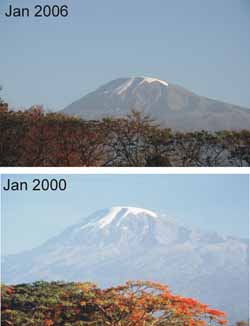I've lent out my copy of
Meltdown by Patrick Michaels so I can't verify that book as the source of most of the following explanation for the disappearing snows of Kilimanjaro, which is very interesting.

Beam me to Planet Gore !
While currently some glaciers are retreating there are others which are thickening. That is historically consistent ... good grief, the earth has seen Ice Ages retreat long before there were SUVs.

Consider the research of Ohio State University glaciologist Lonnie Thompson ... he who predicted in a 10/02 paper in Science an end to Kilimanjaro's glaciers by 2020, more or less, according to current trends. I remember when ABC news picked this up.
Well. much of modern environmental journalism displays a pervasive lack of critical insight toward environmental scares and the scientific papers on which they are supposedly based. An inspection of Thompson's own data, also published in i Science, shows that Kilimanjaro's glaciers would be dying even if i Homo sapiens ancestors were still the dominant hominid in the Rift Valley, a few hundred miles to the West. That is to say, humans are not to blame for the glacial recession.
Thonpson cited five surveys of Kilimanjaro from 1912, 1953, 1976, 1989, and 2000, as per your graphic.
From 1912 to 1953, global temperatures rose (as measured controversially by surface thermometers) 0.4° C (0.74° F). This rise occurred before most of the industrial emissions of so-called "greenhouse gases" , mainly CO2 and CH4. As a result. most scientists think the warming of the 20th century had mainly to do with changes in Mr. Sun. In fact, slight changes in solar output have modulated the earth's surface temperature plus or minus about 1.0° C (1.8° F) over millennia.
Kilimanjaro's glaciers lost 45% of their areal extent during that era of solar warming. If the glaciers had continued to decline at the pace established in that period, they would already be gone by now, pfffft, even with no additional warming from the emissions of greenhouse gases.
But the glaciers are still here. From 1953 through 1976, another 21 percent of the original area was uncovered. This occurred during a period of global cooling of 0.07° C (0.13° F). OSU's press office could logically have written the following hype in 1976: "Kilimanjaro's glaciers will completely disappear by 2015 if this cooling trend continues".
It is patently obvious that global temperatures and their behavior of Kilimanjaro's glaciers are pretty independent, at least on the time scale of decades. Local climate, however, is apparently critical. A glacier cares what happens from its head to its toe, not elsewhere.
The local climate record around Kilimanjaro is confusing. There is very little cohesion between nearby thermometers which argues more that the data are bad than it does for any local cooling or warming. Poor (unsubsidized by Kyoto) countries have little income to spend on a quality climate-monitoring network.
Since, 1976, another 12% of the original mass has disappeared - and despite all the hoopla, a loss of 12% represents the slowest decline since 1912. Although the local temperature measurements are clearly questionable, more recent decades' measurements area as close to perfect as possible. In 1979 satellite monitoring began. All scientists - even the most ardent Anthropogenic Global Warming ™ apocalyptics - acknowledge that the satellite is excellent at measuring temperatures at the altitude of Kilimanjaro's glaciers - about 19,000 feet. In fact, it may measure temperatures at that altitude better than it does at sea level.
Around Kilimanjaro, satellite data shows a cooling of 0.22°C (0.40°F) since 1979, which is the same as the global warming rate between 1912 and 1953 (0.09°C or 0.17°F per decade). Still, Kilimanjaro's glaciers continue to shrink.
In his Science article, Thompson noted that the period from 4,000 to 11,000 years ago was warmer in Africa than it is today, and yet Kilimanjaro was much more glaciated because it was also wetter than it is today. Some estimates place today's precipitation at only 50% of what it was during the warmer period. Obviously, precipitation, not Anthropogenic Global Warming ™ temperature, is the key to the glaciation of Kilimanjaro.
Did people make it stop snowing? Precipitation in East Africa is highly correlated with El Niño activity in the tropical Pacific ocean. During the last big one, 1997-8, how many news stories promulgated the notion that El Niños are becoming more frequent because of AGW?
So someone could argue that humans cause global warming, global warming causes more El Niños, more El Niños affect precipitation, and therefore humans are causing the glaciers to recede. But, if people are causing more El Niños, then in fact it should be snowing more and more on Kilimanjaro - more than it did back in the day when it was even warmer, thousands of years ago.





